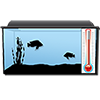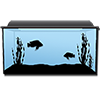

Känd från flodområdena kring Noumbi & Kouilou River




De exemplar man fångat har levt i syrerikt grunt klart vatten över sandig botten, nära strand där grenar och löv skjuter ut över vattnet från stranden och på så vis bilder skuggor. Arten har funnits tillsammans med Nannocharax parvus och två andra omnivora eller herbivora substratelekande ciklider; Coptodon guineensis och Coptodon tholloni.
Head and body yellowish or yellowish-brown, paler ventrally (Figure 6). Scaleless, dark
opercular spot often extending posteriorly over one or two scale rows. Three short dark bars
along mid-flank, not extending to ventrum. Single dark bar or rounded spot in midline or over
dorsal half of caudal peduncle. Flank scales ringed with dark-brown pigment contrasting with
paler central field, more strongly marked in males (Figure 6a) than females (Figure 6b). Ventral
portions of cheek, operculum and chest silvery with a greenish or turquoise flush. Cluster of
silvery scales located lateroventrally around vent, reduced in number and less clearly marked in
males (Figure 6a), prominent in mature females (Figure 6b). Belly flushed pale rosy pink in
mature females. Leading edge of pelvic fin darkly pigmented. Soft dorsal and anal fins with
alternating pale and dark maculae variously evident, but always present. Caudal-fin membranes
with conspicuous rows of maculae, strongest proximally. All fin spotting more prominent in
mature males than in females and juveniles.
Dess lekbeteende är inte känt, men troligen är den parbildande grottlekare, likt andra västafrikanska arter i samma släkte.
Etymologi
Namngiven efter Emil Woolf Kentridge-Young, barnbarn till William Kentridge &
Anne Stanwix, som ett erkännande av deras stöd till forskning i Afrika.